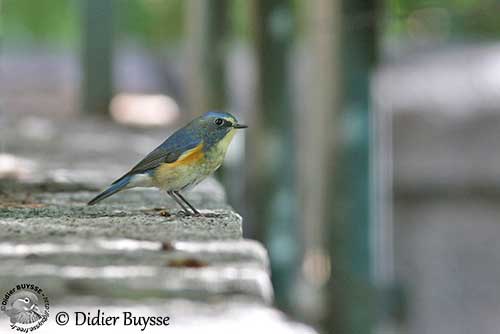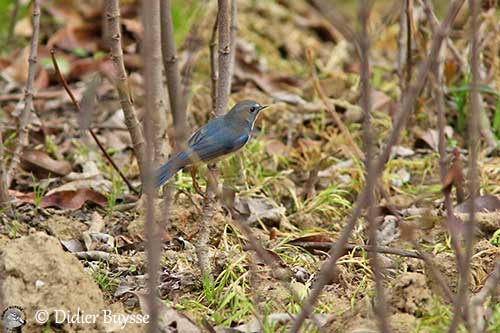
Fr: Robin à flancs roux
Ang: Red-flanked Bluetail - Orange-flanked Bush-Robin
All: Blauschwanz
Esp: Ruiseñor Coliazul
Ita: Codazzurro
Nd: Blauwstaart
Sd: tajgablåstjärt
Photographers:
Didier Buysse
Vision d’Oiseaux
William Price
PBase-tereksandpiper & Flickr William Price
Ingo Waschkies
Bird Photography
Text by Nicole Bouglouan
Sources:
HANDBOOK OF THE BIRDS OF THE WORLD Vol 10 by Josep del Hoyo-Andrew Elliott-David Christie - Lynx Edicions - ISBN: 8487334725
South Dakota Birds and Birding – (Terry L. Sohl)
What Bird-The ultimate Bird Guide (Mitchell Waite)
Wikipedia, the free encyclopaedia
The Guardian - Mystery bird: orange-flanked bush-robin, Tarsiger cyanurus
First record of a Red-flanked Bluetail for Canada
Red-flanked Bluetail or Orange-flanked Bush-Robin
Tarsiger cyanurus
Passeriformes Order – Muscicapidae Family
INTRODUCTION:
The Red-flanked Bluetail or Orange-flanked Bush-Robin is a small Eurasian bird that breeds in the northern part of the range from Finland and NW Russia, to China and N Korea. This migratory species moves southwards after breeding, to S Japan and N SE Asia.
It frequents conifer and mixed conifer forests during the breeding season. It feeds primarily on insects and other small invertebrates, but berries and seeds are also part of its diet in autumn.
It nests in a cup-shaped structure placed on the ground among roots or under rotten log, or in hole in bank.
The Red-flanked Bluetail is described as common throughout most of the range, and the population is considered stable. The species is not currently threatened.

DESCRIPTION OF THE BIRD:
Biometrics:
Length: 13-15 cm
Wingspan: 22-23 cm
Weight: 11 g
The Red-flanked Bluetail adult male has glossy deep blue upperparts. Sides of crown, scapulars, rump and base of rectrices are brighter blue.
The underparts are white from chin to vent, with buffish tinge on the breast. Flanks are orange-rufous, giving the bird its name.
On the blue head, the narrow, white supercilium is conspicuous, but the lores are very dark, almost blackish.
Bill, legs and feet are blackish. The eyes are dark brown.
The male’s plumage becomes browner on crown, back and wings in autumn.
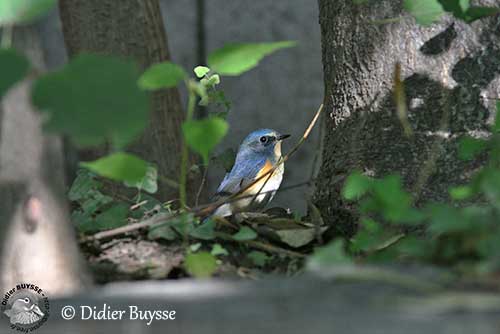
The adult female has mostly olive-brown upperparts, but rump and tail are blue.
On the whitish underparts, chin and throat are white and contrast with a buffy-brown breast band. Flanks are orange-rufous.
On the head, the face is buffy-brown and we can see a narrow, white eyering, sometimes broken.
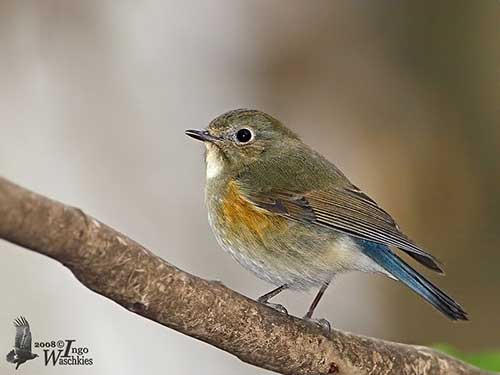
The juvenile resembles female with brownish, spotted buff upperparts and rufous-tinged wings. The tail is blue-grey. Flanks are washed orange.
The 1st winter male is similar to the female. At one year, the plumage is not fully blue above, but the bird is able to breed.
RANGE:
The Red-flanked Bluetail breeds from Scandinavia, E through Russia, Korea, N China and Japan.
It winters in S Japan, S Korea, E and SE China, Taiwan, Hainan and N SE Asia.
HABITAT:
The Red-flanked Bluetail breeds in mixed coniferous forests with dense shrubby undergrowth. It is often found in old growth spruce forest with fallen trees and logs, often on hilly slopes, and also in pine and mixed forests with birch and rhododendron. The latter habitat type is more frequented in the eastern part of the range, up to 3,000 metres of elevation. In China and Japan, it breeds up to 1,500/2,300 metres of elevation, and down to near the sea-level in pine forests in E Hokkaido.
Outside breeding season, it is mainly found in broadleaf evergreen forests, dense undergrowth, thickets, clearings, open woodlands, and on ridges and mountain tops.
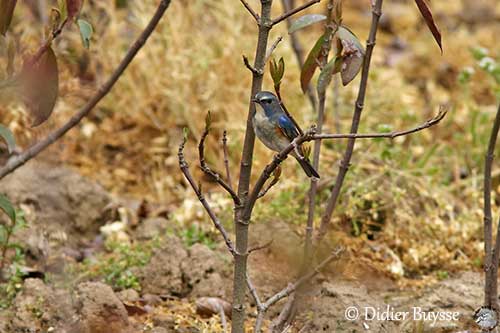
CALLS AND SONGS: SOUNDS BY XENO-CANTO
The Red-flanked Bluetail gives a harsh, low, throaty “tok-tok-tok” often combined with a mournful “heed” given as contact or alarm call.
The song is a short, cheerful warble that lasts less than 2-3 seconds. It is described as “tree tre-tretritt”. It also gives a clear, melodious “whee-wee-whee-wee-wellu-it”.
BEHAVIOUR IN THE WILD:
The Red-flanked Bluetail feeds primarily on insects and spiders, but during the breeding season, it also consumes various small invertebrates.
Outside this period, berries and seeds are also part of the diet.
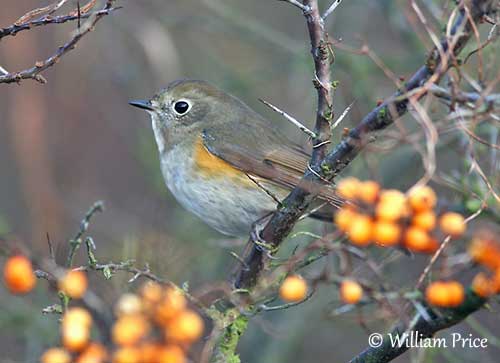
It often forages on the ground where it is very active, searching for food in trees and shrubs. It moves by hopping along while frequently bobbing the tail. It can be seen clambering through the low vegetation, but insects are also caught on the wing, following sallies from perches.

The Red-flanked Bluetail sings throughout the day at the beginning of the breeding season. The displays are not described, but the bright blue plumage and the rufous flanks of the male probably play an important role during the courtship displays.

The Red-flanked Bluetail is migratory and moves southwards after breeding. The species has been expanding its range in recent decades, first westwards to Scandinavia where it breeds more frequently, but also eastwards in migration.
It is vagrant to the Aleutian Islands and other islands of the Bering Sea such as Pribilof Islands and St. Lawrence Island. There are some records on islands off California coast, also in NW USA and SW Canada.
The flight is swift and direct with rapid wingbeats.
REPRODUCTION OF THIS SPECIES:
The breeding season takes place between May and August, with some variations depending on the range. This species produces a single brood, occasionally two per season.
The Red-flanked Bluetail nests in a cup-shaped structure built on the ground in a cavity or a depression, among roots, under a rotten log, or in hole in bank.
The cup is made with grass, moss, twigs and rootlets. It is lined inside with finer grass, hair, feathers or wool.
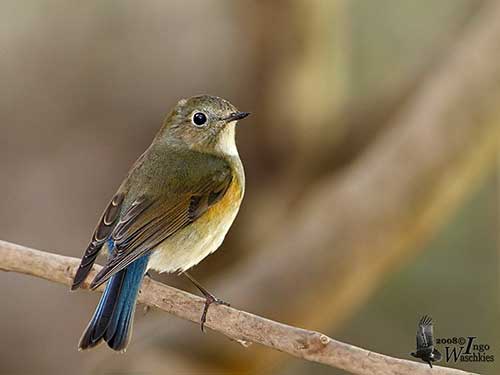
The female lays 4-7 white eggs with brown speckles. She incubates alone during 12-15 days. Both parents feed and rear the chicks. The young fledge about 15 days after hatching.
PROTECTION / THREATS / STATUS:
The Red-flanked Bluetail is widespread and common throughout the wide range.
The size of the population is unknown but it is suspected to be stable. The small European population that forms 5% of the global range is estimated to be increasing (2015).
The Red-flanked Bluetail is not globally threatened, and currently evaluated as Least Concern.
